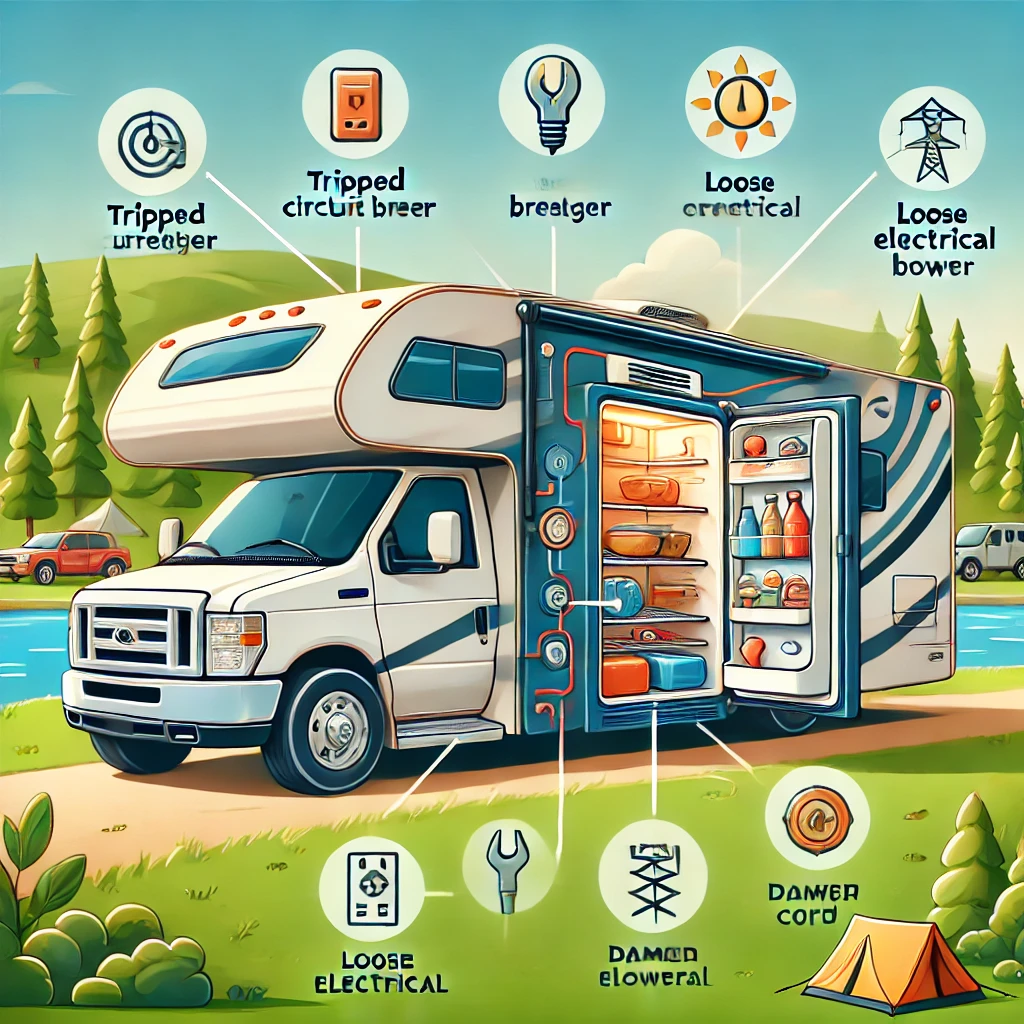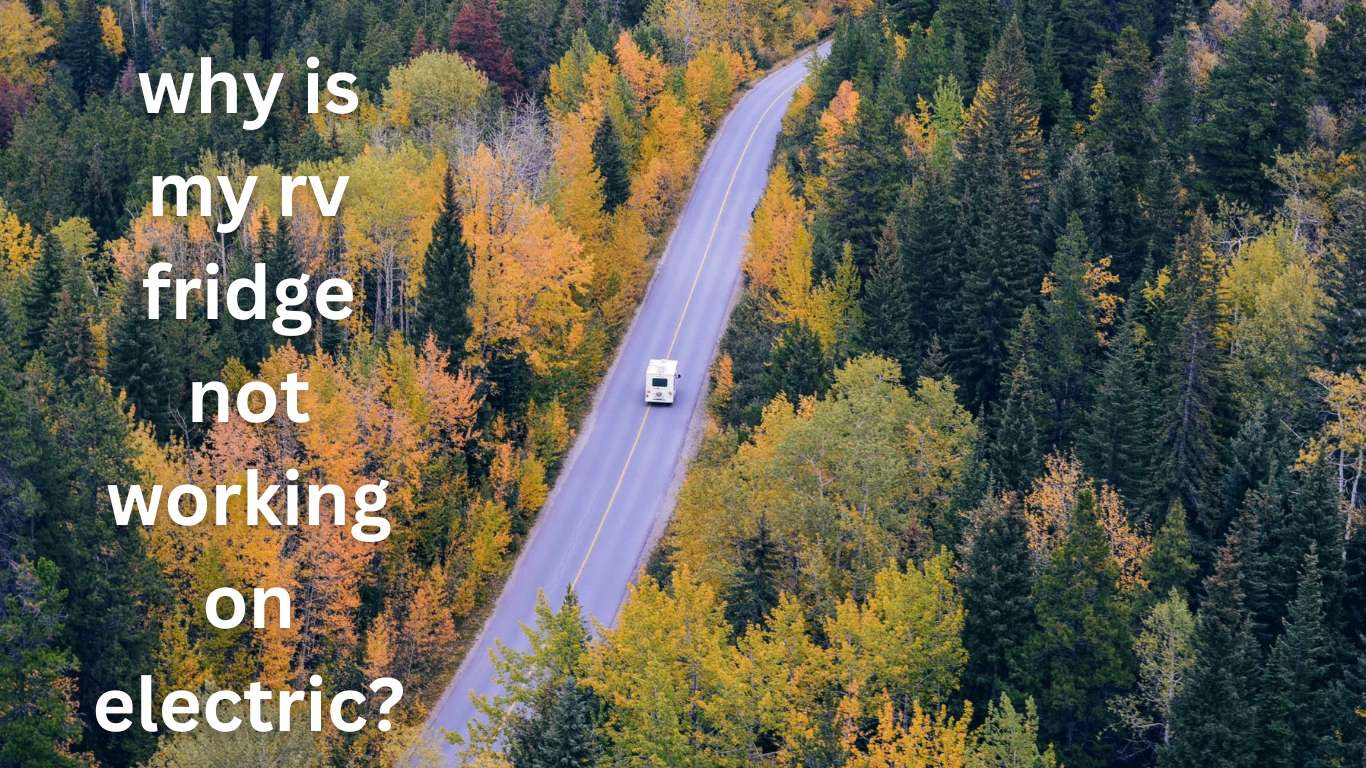RV refrigerators are a vital component for comfortable travel, but when they fail to run on electric power, it can be frustrating. Understanding the common causes and solutions can save time and ensure your trip goes smoothly.
Common Reasons Your RV Fridge Isn’t Working on Electric
1. Power Supply Issues
Your RV fridge relies on a steady electrical supply. Check these common culprits:
- Blown Circuit Breaker or Fuse: Inspect the breaker box for any tripped breakers or blown fuses and reset or replace them if needed.
- Loose or Damaged Power Cords: Verify the fridge’s power cord is securely connected and free from damage.
2. Faulty Heating Element
The heating element in an RV fridge converts electric power into heat to facilitate cooling. If it’s defective:
- Test the heating element with a multimeter for continuity.
- Replace the element if it’s malfunctioning.
3. Thermostat or Control Board Problems
A malfunctioning thermostat or control board may prevent your fridge from switching to or operating on electric mode.
- Inspect the thermostat for accurate temperature settings.
- Consult a technician to test or replace the control board if needed.

Factors Affecting Why Your RV Fridge Is Not Working on Electric
When your RV fridge fails to run on electric, several factors could be at play. Identifying the root cause ensures efficient troubleshooting and helps get your refrigerator back in working order.
Electrical Factors
1. Power Supply Problems
- Insufficient Voltage: RV fridges require a stable voltage; fluctuations can disrupt their operation.
- Faulty Shore Power or Generator: Check the external power source to ensure consistent delivery.
2. Wiring and Connections
- Damaged Wires: Frayed or exposed wires can interrupt the electric flow.
- Loose Connections: Verify all plugs and connectors are secure.
Component Failures
1. Heating Element Malfunction
The heating element converts electric power into heat for cooling. A defective element can prevent the fridge from functioning.
2. Control Board or Thermostat Issues
These components regulate the fridge’s operations. Faulty boards or inaccurate thermostats can block electric mode.
Environmental Factors
1. Extreme Temperatures
High or low ambient temperatures can reduce the efficiency of RV fridges, especially if they’re already underpowered.
2. Leveling Problems
RV refrigerators need to be level to operate correctly. Improper leveling can disrupt the cooling process.
Maintenance Factors
1. Dirty or Blocked Vents
Dust, debris, or obstructions in the fridge’s vents can lead to overheating and electrical issues.
2. Lack of Regular Inspection
Failing to check for wear and tear can allow minor issues to escalate into significant problems.

Understanding the Different Classes of RVs
RVs come in a variety of classes, each tailored to different travel styles, family sizes, and levels of luxury. Whether you’re looking for a compact camper or a fully equipped motorhome, there’s an RV class to fit your needs.
Class A Motorhomes
What Are Class A Motorhomes?
Class A RVs are the largest and most luxurious motorhomes, resembling buses with flat fronts. They are ideal for long-term travel or full-time living.
Key Features
- Spacious interiors with multiple slide-outs.
- Equipped with full kitchens, bathrooms, and sometimes washers and dryers.
- Often include luxury amenities like king-sized beds, entertainment systems, and premium finishes.
Best For:
Families or couples who want a home-like experience on the road with maximum comfort.
Class B Motorhomes (Camper Vans)
What Are Class B RVs?
Class B RVs are compact, van-style motorhomes built for easy driving and minimal setups.
Key Features
- Compact size, typically 18–24 feet long.
- Basic living essentials, such as a small kitchen, bathroom, and sleeping area.
- Easy to park and maneuver, even in urban areas.
Best For:
Solo travelers or couples who value mobility and simplicity over space.
Class C Motorhomes
What Are Class C Motorhomes?
Class C RVs bridge the gap between Classes A and B, featuring a cab-over design that offers extra sleeping or storage space.
Key Features
- Built on a truck or van chassis, making them easier to drive than Class A.
- Provide full living amenities, including a kitchen, bathroom, and multiple sleeping areas.
- Available in a range of sizes, accommodating families or small groups.
Best For:
Families or travelers who need more space but prefer a manageable driving experience.
Towable RVs: Travel Trailers and Fifth Wheels
Travel Trailers
- Lightweight and versatile, they can be towed by SUVs, trucks, or crossovers.
- Come in various sizes, from compact teardrops to large models with slide-outs.
- Detach from your vehicle, allowing you to use your car for local trips.
Fifth Wheels
- Larger towable RVs with a unique hitch that attaches to a truck bed.
- Offer spacious, multi-level layouts with high ceilings and luxury amenities.
- Provide a home-like feel for extended stays.
Pop-Up Campers
What Are Pop-Up Campers?
Pop-up campers are lightweight trailers with collapsible sides that make them easy to tow and store.
Key Features
- Basic sleeping and cooking facilities.
- Affordable and perfect for weekend trips or beginners.
- Require minimal maintenance and setup time.
Best For:
New campers or those with smaller vehicles who want a budget-friendly RV option.
Toy Haulers
What Are Toy Haulers?
Toy haulers are versatile RVs that combine living quarters with a garage space for motorcycles, ATVs, or other gear.
Key Features
- Available in motorized or towable options.
- Perfect for outdoor enthusiasts who travel with equipment.
- The garage area can double as additional living space.
Best For:
Adventure seekers who need space for recreational toys and outdoor gear.
How to Resolve the Problem of an RV Fridge Not Working on Electric
If your RV fridge isn’t working on electric, don’t worry—this issue is common and often fixable with a few troubleshooting steps. By identifying the underlying cause, you can get your refrigerator running smoothly again and ensure your trips stay stress-free.
Step 1: Check the Power Supply
Verify Shore Power or Generator
- Ensure your RV is properly connected to shore power or that the generator is running and supplying adequate voltage.
- Use a multimeter to check if the power outlet is providing the correct voltage (typically 110-120V).
Inspect Circuit Breakers and Fuses
- Look for tripped breakers in your RV’s electrical panel. Reset any tripped breakers.
- Replace blown fuses associated with the fridge’s power supply.
Step 2: Examine the RV Fridge Settings
Switch to Electric Mode
- Ensure the fridge is set to “Electric” or “Auto” mode. The “Auto” setting automatically switches between electric and propane.
Check Thermostat Settings
- Verify the thermostat is set to the desired temperature. Malfunctioning thermostats can disrupt the fridge’s cooling on electric.
Step 3: Inspect the Heating Element
Test for Continuity
- Use a multimeter to test the heating element for continuity. A defective heating element will need replacement.
Look for Visible Damage
- Inspect the heating element for burns, cracks, or other signs of damage that could affect performance.
Step 4: Assess Wiring and Connections
Inspect Cords and Plugs
- Ensure the fridge’s power cord is securely plugged in and free from damage.
- Look for loose, frayed, or disconnected wires in the fridge’s electrical system.
Clean Power Terminals
- Corrosion on power terminals can disrupt the electric supply. Clean them with a wire brush if needed.
Step 5: Test the Control Board
Look for Error Codes
- Many modern RV fridges display error codes when components fail. Consult the owner’s manual for code meanings.
Inspect the Circuit Board
- If the control board is faulty, it might not recognize the electric mode. Have it tested by a professional and replaced if necessary.
Step 6: Check for Ventilation or Leveling Issues
Ensure Proper Ventilation
- Blocked vents can overheat the fridge, causing it to malfunction. Clean vents and remove obstructions.
Level the RV
- An unlevel RV can disrupt the fridge’s cooling process. Use a leveling tool to ensure the RV is stable.
When to Seek Professional Help
If these steps don’t resolve the problem, consult an RV technician to:
- Test internal fridge components like the cooling unit.
- Address complex wiring or control board failures.

Common Mistakes and Solutions for RV Fridges Not Working on Electric
RV fridges are complex appliances, and certain mistakes can lead to them failing on electric power. Knowing these errors and their solutions can save you time and hassle while on the road.

Mistake 1: Forgetting to Check the Power Supply
Problem
Overlooking the shore power connection, generator output, or RV circuit breaker can result in your fridge not receiving electricity.
Solution
- Ensure your RV is plugged into a reliable power source.
- Test the power outlet with a multimeter to confirm proper voltage.
- Reset any tripped breakers and replace blown fuses in your RV’s electrical panel.
Mistake 2: Ignoring Fridge Settings
Problem
Not setting your fridge to the correct mode (electric or auto) can prevent it from switching to electric power.
Solution
- Verify the fridge is set to “Electric” or “Auto” mode.
- Double-check the thermostat settings to ensure the desired temperature is selected.
Mistake 3: Overlooking the Heating Element
Problem
The heating element is a critical component for the fridge’s cooling cycle when using electric power. Neglecting to inspect it can lead to prolonged issues.
Solution
- Test the heating element for continuity using a multimeter.
- Replace it if it shows no continuity or visible damage like cracks or burns.
Mistake 4: Neglecting Regular Maintenance
Problem
Dirty vents, clogged coils, or corroded connections can reduce the fridge’s efficiency and cause it to fail on electric.
Solution
- Clean the fridge’s external vents and interior coils regularly.
- Inspect and clean electrical connections to remove corrosion.
Mistake 5: Not Leveling the RV
Problem
Operating the fridge in an unlevel RV disrupts the flow of coolant, which can cause it to stop working.
Solution
- Always level your RV before starting the fridge. Use a bubble or digital level to ensure accuracy.
Mistake 6: Ignoring Wiring and Connections
Problem
Loose or damaged wires are a common but often overlooked reason for an RV fridge not working on electric.
Solution
- Inspect all wiring connections for frays or loose ends.
- Tighten loose connections and replace damaged wires immediately.
Mistake 7: Overlooking Error Codes
Problem
Modern RV fridges often display error codes when there’s an issue, but these codes are ignored or misunderstood.
Solution
- Refer to the owner’s manual to interpret error codes.
- Address the specific issue indicated by the code, such as faulty control boards or sensors.
Final Thoughts
By avoiding these common mistakes and implementing the suggested solutions, you can keep your RV fridge working reliably on electric power. Regular maintenance, proper operation, and timely troubleshooting are the keys to enjoying worry-free adventures.
Make these tips a habit, and you’ll save yourself from unnecessary headaches on the road!
More related details will be available on Flamingo Motorhomes.

